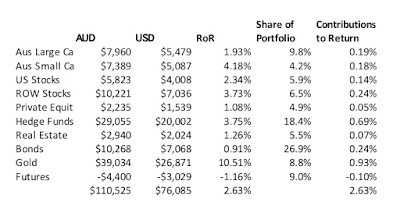Here is our spending for the Australian financial year 2019-2020. The shaded areas are sub-categories of the main categories above them. The table also shows the spending shares in the previous financial year and the change in share. These numbers include some spending that we don't include in our usual monthly reports to make the report more comparable to others you might see online. This includes mortgage interest and life insurance. Health insurance and medical expenses are net of reimbursements by the health insurer and the government. All numbers are in Australian Dollars.

Monthly spending increased from $10.7k to $12k (USD 8,250). This is more than my after-tax salary... Housing was again the largest spending category but supermarkets overtook health as the second largest. Spending on mail order and childcare and education are now both ahead of health. The shares of health and housing fell the most due to reduced mortgage interest and medical spending. Our second child was born 26 June 2019 and expenditure around that was mostly incurred in the previous financial year but we got some reimbursements in this financial year. Mortgage interest was down because we had a lot of money in our offset account leading up to the "
mortgage inversion" and because the loan is just getting smaller and interest rates are falling.
I spent a lot more on taxis and Uber (I don't have a driving licence). A lot of this was because in the early months of Moominmama's maternity leave I took Moomin to daycare at her workplace before going on to my work. But also, I am getting less patient with the time it takes to get around on public transport when I have increased childcare duties. When it's convenient I get a bus, when it's not I get an Uber or taxi.
Childcare expenditure rose because we now have two children and because we got a lot less subsidy as our income rose. On the other hand, after the pandemic started we got free childcare, so this category will rise even more next year, probably. Mail order spending was up 86% on last year. This is partly because after Moominmama went on maternity leave she did a lot more mail order. But department store (all non-supermarket goods retail) and supermarket spending were also up. Across the three categories, spending was up 47%. Cash spending fell further to just $1,600, though some of the supermarket spending includes cash withdrawals by Moominmama.
I'm also tracking income, tax, and savings in the same spreadsheet. But these numbers are all still really uncertain until we are ready to submit our tax returns in a few months time. Very roughly, half our income goes to spending, a quarter to tax, and a quarter to saving.











